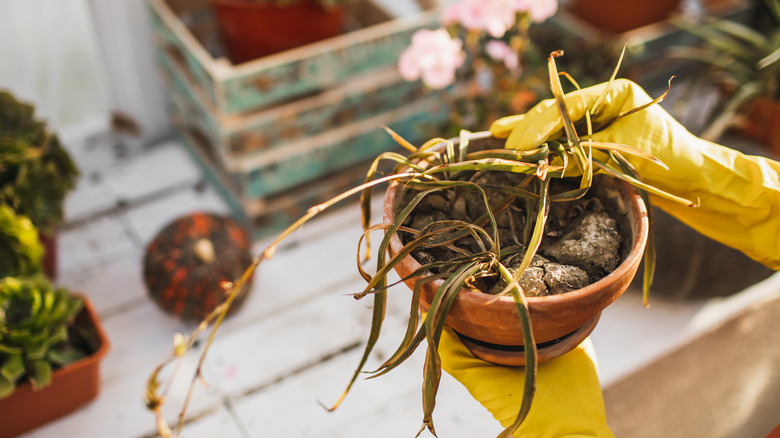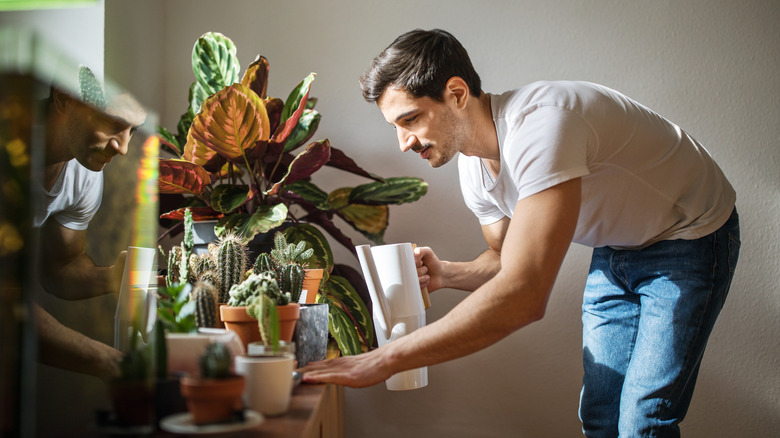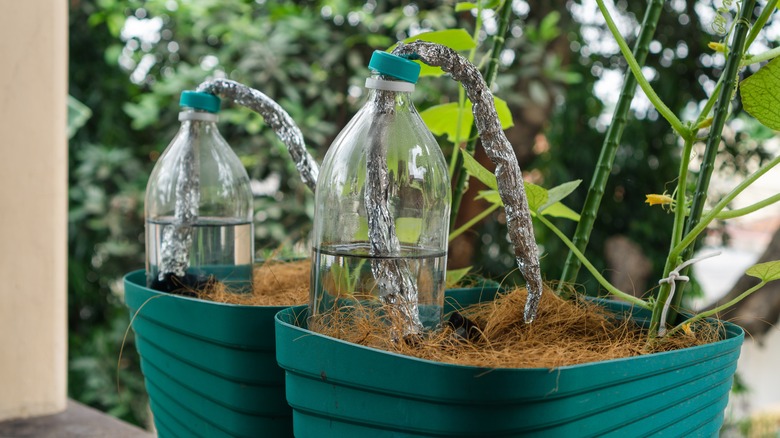How To Know If Your Plants Can Be Revived After A Lack Of Water
We may receive a commission on purchases made from links.
We've all been there — you have an exceptionally busy week, you've been distracted, or maybe you went away for a few days and forgot to water the plants first. Perhaps you just don't have a green thumb. Either way, the plants aren't looking great. It's easy to jump to the worst-case scenario, but the situation might not be quite as dire as you think. In fact, underwatering your plants is actually less damaging than overwatering them, which can lead to numerous irreversible issues. However, a thirsty plant is not necessarily a dead plant.
Ignore the crispy or fallen leaves (which you'll want to remove anyway) and go straight for the stem and roots, which will tell you everything you need to know. Ideally, the stem should be flexible, firm, and green in color. If it seems fragile and mushy, move on to the roots — removing it from its pot for inspection. If its roots are also mushy and rotten, sadly, the plant is likely beyond saving. If the stem is rotten but the roots remain intact, remove the stem bit by bit to ensure none of it is alive. If there is no living stem, cut it until roughly 2 inches remain and move the plant to an area where it gets about half as much sun as normal and water whenever the soil feels dry to the touch.
Tips to correct your watering methods
Know, too, that forgetting to water might not be why your plant seems underwatered; it might not be absorbing water effectively thanks to compact soil, aka the "gap of death." One way to rectify this issue is to try using bottom watering, a method where the plant is placed in a tub, sink, or something of the like for roughly 30 minutes or until the topsoil is moist to the touch. Be sure to let the plant drain for roughly the same amount of time afterward. After soaking and moving it to a safe spot with indirect sunlight, remember to be patient; it can take up to a month for your plant to recover.
In general, different types of plants require different amounts of water, but a good rule of thumb is to stick your finger into the soil up to the second knuckle. If your finger comes out dry, it's time to water your plant. If it's moist, you're good to wait. You can also employ the three-second rule. However, this doesn't solve the problem of remembering to water your plants or managing them when you're out of town. You can purchase something like this RUNWUSHENG automatic drip irrigation system or these Mission Gallery plant watering globes, both from Amazon or simply DIY with objects you likely already have.
DIY watering hacks for forgetful plant parents
One of the easiest plant watering hacks is to repurpose a wine or water bottle into an irrigation tool. For a wine bottle system, choose a bottle with a twist-off cap. Use a hammer and nails to make two or three small holes in the cap. Then, fill the bottle with water and insert it upside-down into the soil, about three inches deep. A water bottle system works similarly but offers more flexibility in size. Simply make several holes in the bottom of the water bottle, fill it with water, and bury it upside-down in the soil, leaving a few inches exposed.
Another easy option is to make a water-wicking drip system, which allows you to water several plants from a single source. It's as simple as choosing a water source taller than your plant pots (think pitchers, buckets) and running garden twine or a cotton cord from the water to your plants when the other end is pressed firmly into the soil. You can also order an Omeric self-watering wick cord from Amazon. If you're going to use one of these methods when you're out of town, remember to practice first to ensure there are no issues. If all else fails, you can always purchase a self-watering plant that takes care of itself.


